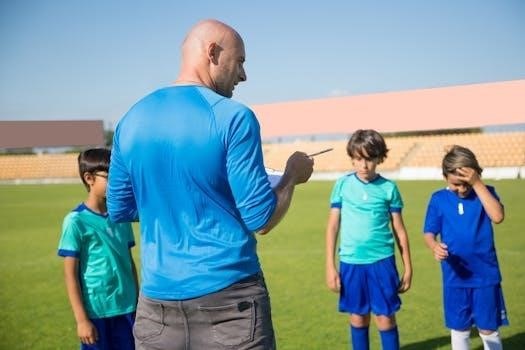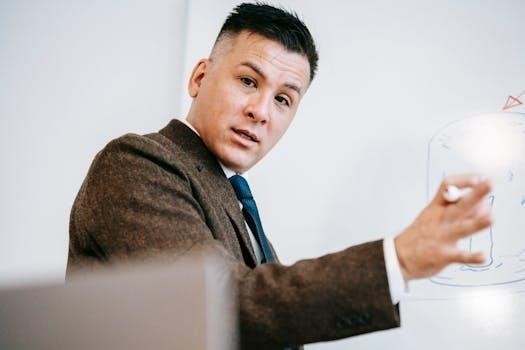Both teaching and coaching share a fundamental similarity⁚ helping individuals gain knowledge, skills, and competencies. This involves imparting information, demonstrating techniques, and guiding the learner toward mastery.
Both teaching and coaching are fundamentally about guiding someone to acquire new knowledge and skills. This shared goal involves structured instruction, feedback, and practice. In both roles, the instructor or coach facilitates learning by breaking down complex information into manageable steps. They demonstrate techniques, provide constructive criticism, and create opportunities for the learner to apply what they’ve learned. Whether it’s a teacher explaining a mathematical concept or a coach demonstrating a sports technique, the aim is to help the individual develop competence and confidence. The effectiveness of both teaching and coaching depends on the ability to communicate clearly, adapt to different learning styles, and create a supportive environment that encourages growth.
Both teaching and coaching are inherently goal-oriented processes. Whether in a classroom or on a field, both teachers and coaches start with the end in mind, defining specific objectives to be achieved. This involves identifying desired outcomes and establishing clear benchmarks for progress. In teaching, goals may include mastering specific academic concepts or developing critical thinking skills. In coaching, goals often focus on improving athletic performance or achieving personal development milestones. The instructor or coach utilizes their expertise to create a roadmap, outlining the steps necessary to reach these goals. Regular assessment and feedback are used to track progress and make adjustments as needed, ensuring that the learner stays on track and motivated towards achieving their desired outcomes.

Similarities Between Teaching and Coaching
Knowledge and Skill Development
Goal-Oriented Approach
Structured, Step-by-Step Process
Both teaching and coaching involve a structured, step-by-step process to facilitate learning and development. This systematic approach ensures that individuals build a solid foundation of knowledge and skills before progressing to more complex concepts or techniques. Teachers and coaches break down complex tasks into smaller, manageable steps, providing clear instructions and guidance at each stage. This allows learners to gradually acquire the necessary skills and confidence to tackle increasingly challenging tasks. The process typically involves a combination of instruction, demonstration, practice, and feedback. Regular assessments are used to monitor progress and identify areas where additional support may be needed. By following a well-defined, step-by-step process, teachers and coaches can effectively guide individuals toward achieving their learning and performance goals, fostering a sense of accomplishment and continuous improvement.
Differences Between Teaching and Coaching
While coaching may appear similar to teaching, the fundamental difference lies in the coach’s deep commitment to the students overall growth. Coaching uncovers and nurtures talents within the student;
Focus on Overall Growth vs. Specific Skills
Teaching often focuses on imparting a broad range of knowledge and skills, following a curriculum designed to ensure students acquire a comprehensive understanding of a subject. The emphasis is on academic growth and the development of a well-rounded individual. In contrast, coaching tends to concentrate on specific skills or aspects of performance.
Coaches work to refine existing abilities, identify areas for improvement, and develop strategies to enhance performance in a particular domain. This targeted approach allows for a deeper dive into specific skill sets, with the goal of achieving tangible and measurable results. The commitment lies in overall growth.
While teachers aim for holistic development, coaches prioritize targeted improvement.
Drawing Out Knowledge vs. Imparting Knowledge
A key distinction lies in how knowledge is approached. Teaching often involves imparting knowledge, with the teacher acting as the expert who delivers information to students. The focus is on sharing expertise, drawing from past experiences, and providing a structured framework for learning new concepts. Coaching, on the other hand, emphasizes drawing out knowledge from the individual being coached.
The coach facilitates the learner’s discovery of their own potential and solutions, asking questions that encourage self-reflection and critical thinking. This approach empowers individuals to take ownership of their learning and development, fostering a deeper understanding and application of knowledge. The coach makes you the hero.
Coaching is about helping someone maximize their performance by guiding them.
Theoretical vs. Practical Learning
Another significant difference is the balance between theoretical and practical learning. Teaching often emphasizes theoretical knowledge, focusing on concepts, principles, and frameworks that provide a foundation for understanding a subject. Students may learn about theories and models in a classroom setting.
Coaching, however, leans towards practical learning in the real world. It involves applying knowledge and skills in real-life situations, with the coach providing guidance and feedback along the way. The focus is on developing practical skills and competencies that can be immediately applied to achieve specific goals.
Coaching is multi-dimensional, cyclical activity that aims to bring out a particular aspect from the subject. Coaching helps someone to learn, unlike teaching where a teacher has an active role in imparting knowledge.
Directive vs. Collaborative Approach
The approach to instruction differs significantly. Teaching is often more directive, with the teacher taking on the role of expert and imparting knowledge to students. The teacher sets the curriculum, delivers lectures, and assesses student learning through tests and assignments.
Coaching, however, is more collaborative. The coach works with the individual to help them maximize their performance. Instead of telling a client exactly what they need to do, the coach uses honed collaboration.
The coach facilitates learning by helping the individual identify their strengths and weaknesses. Coaching is more two-way, and less of a sage on the stage situation. This fosters a more engaged and empowered learning experience.
A significant aspect of coaching involves uncovering and nurturing hidden talents within the student that they may not have realised. Coaches aim to help people reach their maximum potential.
Nurturing Hidden Talents
A significant aspect of coaching involves uncovering and nurturing hidden talents within the student that they may not have realised. Coaches aim to help people reach their maximum potential. Coaching focuses on drawing out existing knowledge and skills rather than simply imparting new information; This involves identifying strengths and weaknesses, providing support, and challenging individuals to push beyond their comfort zones.
Unlike teaching, which often follows a standardized curriculum, coaching is highly individualized. The coach works closely with the individual to understand their unique goals, aspirations, and learning style. Through active listening and insightful questioning, the coach helps the individual to identify and overcome obstacles, develop new strategies, and achieve their full potential. This personalized approach is essential for unlocking hidden talents and fostering personal growth.
Emphasis on the Individual
Coaching places a strong emphasis on the individual, tailoring the approach to their specific needs and goals. Unlike teaching, which often involves a more standardized curriculum, coaching is highly personalized, focusing on the individual’s unique strengths, weaknesses, and aspirations. This individual-centric approach recognizes that each person learns differently and has different potential.
A coach works closely with the individual to understand their specific challenges and helps them develop strategies to overcome those challenges. This collaborative process empowers the individual to take ownership of their development and achieve their goals. The coach acts as a guide, mentor, and facilitator, supporting the individual’s journey toward self-discovery and growth. This personalized attention fosters a deeper understanding of oneself and unlocks the individual’s full potential.

Key Aspects of Coaching
Multi-Dimensional, Cyclical Activity
Coaching is not a linear process but rather a multi-dimensional, cyclical activity. It involves continuous assessment, feedback, and adaptation. The coach works with the individual to identify areas for improvement, develop strategies, and implement those strategies. This process is constantly evolving as the individual progresses and new challenges arise.
The cyclical nature of coaching allows for continuous learning and growth. As the individual implements new strategies, the coach provides feedback and guidance, helping them refine their approach and achieve better results. This iterative process ensures that the individual is constantly moving forward and developing their skills. The multi-dimensional aspect of coaching recognizes that individuals are complex and that their development is influenced by various factors. A coach takes a holistic approach, considering the individual’s strengths, weaknesses, values, and goals to create a personalized coaching plan.

Qualifications and Compensation
Educational coaches typically need specific qualifications. Salaries vary by location and specialty, but professional coaches often earn more per hour than teachers due to their specialized skills.
Educational Coaching Requirements
To become an educational coach, specific qualifications are generally required. While the exact requirements may vary depending on the specific role and the institution, some common prerequisites often include a background in education, such as a teaching degree or relevant experience in the field.
Furthermore, many educational coaching positions require advanced certifications or training in coaching methodologies. These certifications can provide coaches with the necessary skills and knowledge to effectively guide and support teachers or students in their professional development;
Additionally, experience in a specific subject area or grade level may be beneficial for coaches who specialize in a particular area of education.
Salary Differences
When comparing the salaries of teachers and coaches, it is essential to consider various factors that can influence compensation levels. Generally, professional coaches often earn more per hour than teachers. However, this can vary significantly depending on the location, specialization, and experience of the individual.
Teachers’ salaries are typically determined by their education level, years of experience, and the school district or institution where they are employed. Coaches’ salaries, on the other hand, may be influenced by their level of expertise, the type of coaching they provide, and the demand for their services.
Ultimately, the salary differences between teachers and coaches can be substantial, but they are subject to various market forces.

Essential Coaching Traits
A good coach embodies many positive traits. However, the 3 Cs of exceptional coaching are courage, compassion, and curiosity. These traits foster trust, understanding, and a growth mindset, essential for effective coaching.
Courage, Compassion, and Curiosity
Courage in coaching means confronting difficult conversations and challenging the coachee’s limiting beliefs. It requires the coach to step outside their comfort zone and provide honest, direct feedback, even when it’s uncomfortable. Compassion involves understanding the coachee’s perspective and showing empathy for their struggles. It means creating a safe and supportive environment where the coachee feels comfortable taking risks and being vulnerable.
Curiosity is the driving force behind effective coaching. A curious coach asks open-ended questions, actively listens to the coachee’s responses, and seeks to understand their unique strengths and challenges. This inquisitiveness allows the coach to tailor their approach to the individual and help them unlock their full potential. These three traits combined enable a coach to nurture growth.
